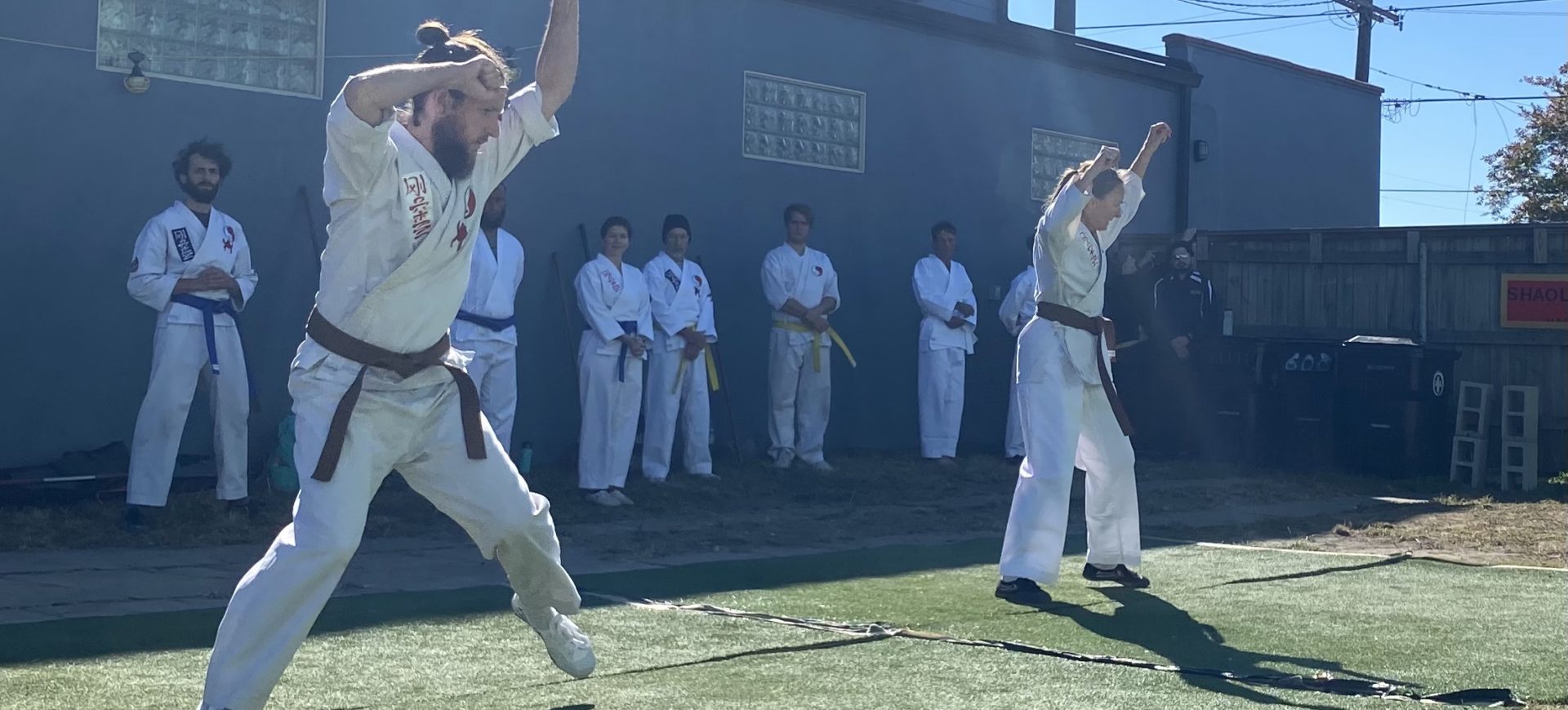TRAIN THE BODY, MIND, AND SPIRIT
Living in New Orleans, we need a positive space in our lives to work on improving ourselves and restoring our spirits in a fun, healthy, and supportive atmosphere.
Our Shaolin kung fu belt-ranking program offers a time-tested, structured path to strength, mindfulness, efficient use of energy, health, fitness, agility, renewed self-confidence, and personal safety.
Add best of all, our program builds relationships and connects you to to a community of people from all walks of life.
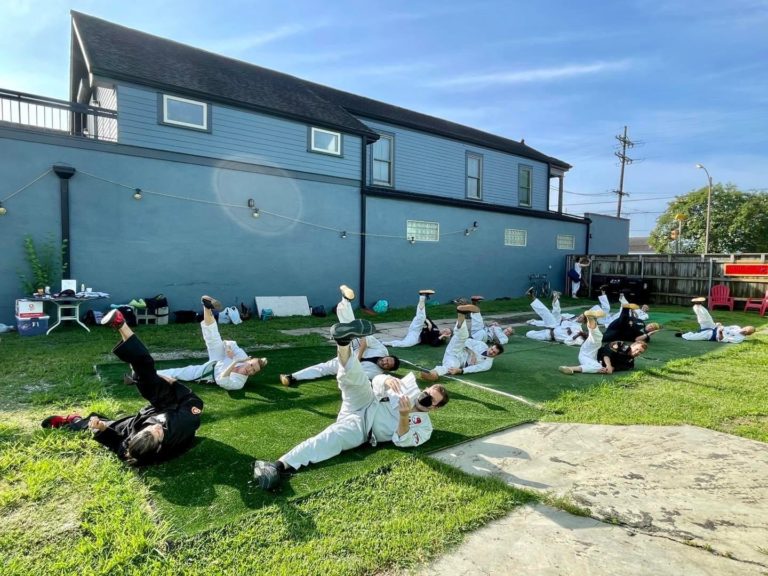
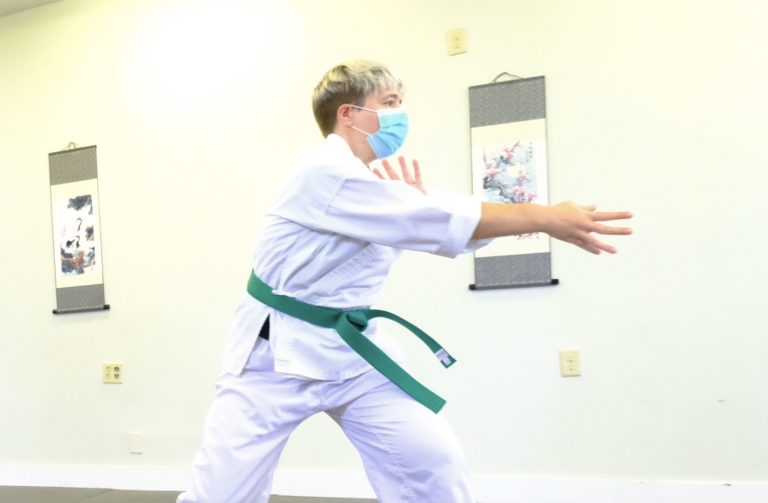
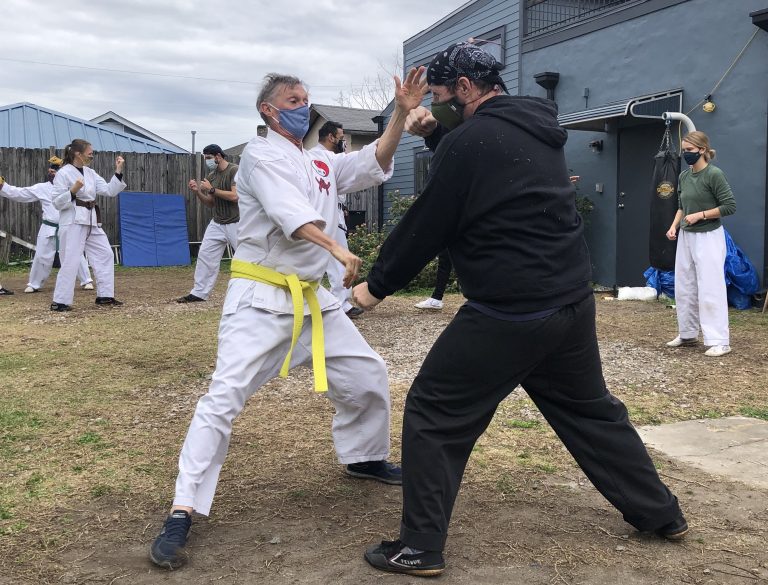
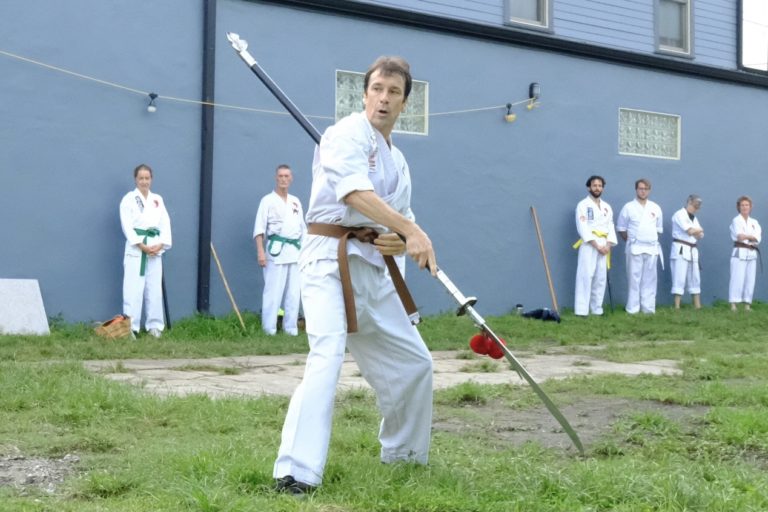
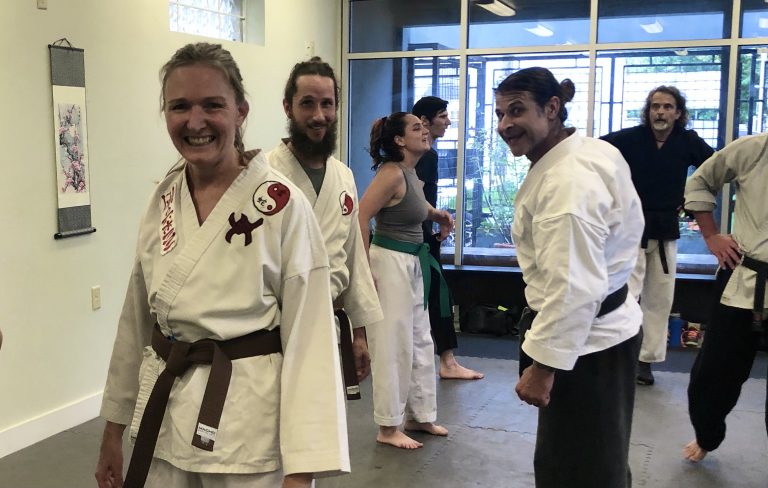
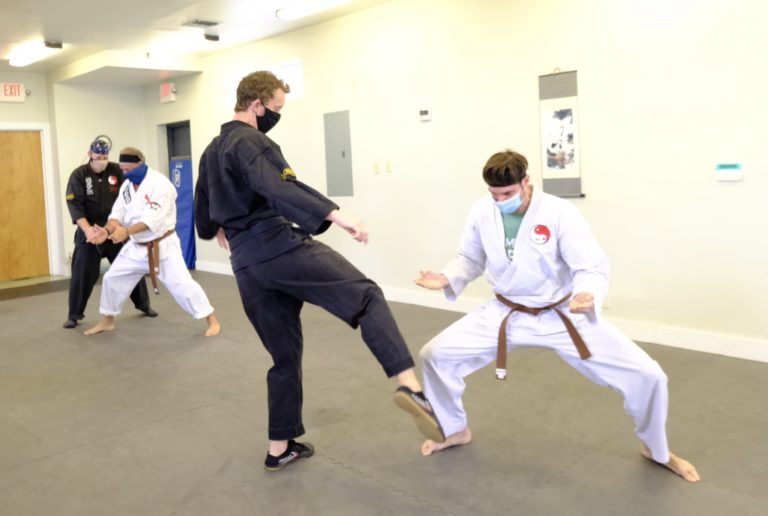
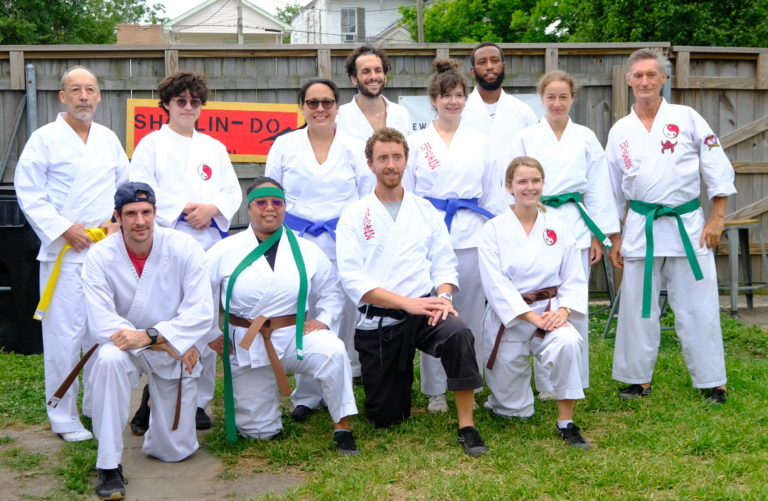
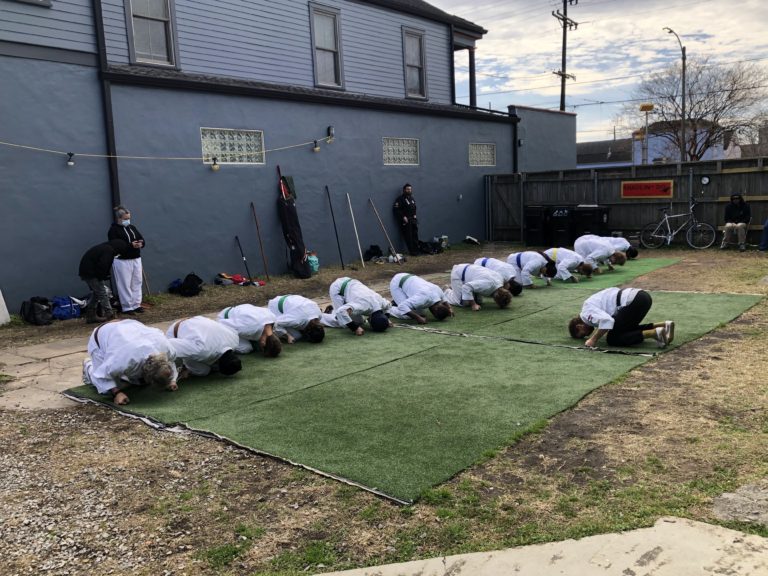
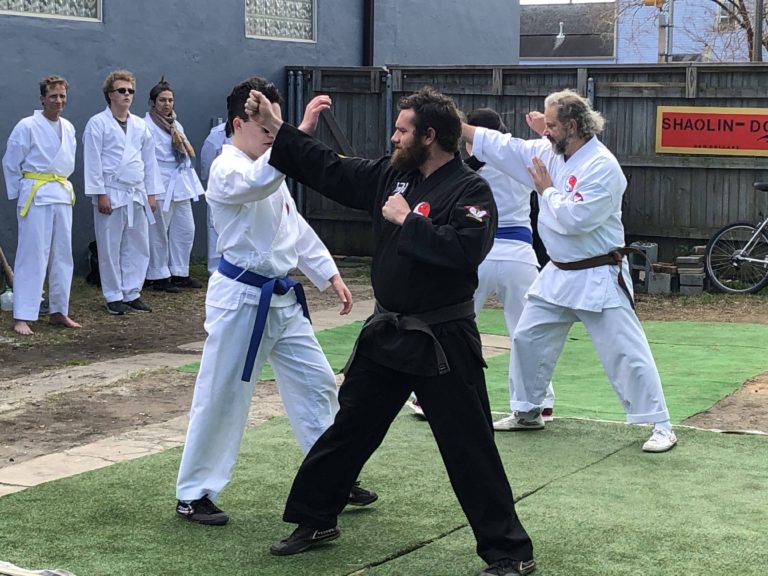
The Practice
Shaolin Kung Fu training is a wholistic practice that consists of many components. Over time we work each area, like slowly polishing each side of a multi-faceted jewel until ultimately the whole gem shines brighter.
Here are brief descriptions of what makes up a Shaolin kung fu practice:
- Empty-Hand Forms – a series of movements, like a dance, to teach different traditional Shaolin kung fu styles like Tiger, White Crane, Monkey, Eagle, and Mantis. These make up the majority of our belt-ranking system and must be practiced until they can be demonstrated before a student advances rank.
- Weapons – forms that teach us how to flow and move with traditional weapons like staff, nunchucks, sai, sword, and spear
- I Chin Ching – ancient exercises like yoga meant to open specific joints and increase the neural drive to certain parts of the body
- Bag Work – striking and kicking a kick-shield held by another student to learn power generation by connecting our bodies up from the ground
- Partner Drills – get hands-on experience with a partner to make sure techniques are grounded in reality. Includes joint-locks, and sparring scenarios.
- Sparring – start developing your own fighting style by practicing against your classmates while drawing from everything you learn
- Qigong (chi kung)- movements to harmonize awareness, body, and energy (chi)
- Meditation – calm the mind, relax the body, and become very still
Purchase a drop-in or one of the above packages.
Come through the front door or our studio or through the wooden gate into our private side yard.
Arrive a few minutes early to sign a waiver form and to meet your instructor and fellow students. Wear something loose-fitting and comfortable and bring a water bottle and small towel.
Class will begin with a warm-up and then move through some of the following:
- I Chin Ching (learn more in our online manual)
- solo kicking and punching drills with mobility exercises
- partner self-defense techniques against common attacks.
- bag-work
- light sparring (this is always geared toward the comfort level of beginners)
Most classes will end with gentle stretching and meditation.
"THE PRACTICE IS THE GOAL"
Before attaining black belt the student will learn 21 long forms covering 7 different kung fu open hand systems and 6 weapons as well as over 50 self-defense techniques practiced against a partner using simulated street attacks.
In the process each student will have overcome numerous physical and mental barriers that seemed previously insurmountable. Beyond that, they will have achieved things that were completely unknown as even a possibility.
It’s this transformational process, and its applicability into everyday life, that is the true fruit of martial arts training.
The Shaolin-Do Curriculum
“Shaolin-Do” means the way of Shaolin. Our belt-ranking curriculum has been passed down to us by our Grandmaster Sin Kwang The and is the method for achieving results in your body and mind.
In the Shaolin temple there were only four recognized levels; student, disciple, master, and grandmaster.
Our Great Grandmaster, Ie Chang Ming, introduced the use of colored belts to divide the “Student” material into five levels: white, yellow, blue, green, and brown. This then designated the black belt as the “Disciple” level which means you are ready to deep-dive into the art.
White belt focuses on basics to build the mind-body connection and balance necessary for proper mechanics. After White, an introductory form, or forms, from a new animal style and a weapon are taught at each level. Through green belt, the priority is on building strength and basic self defense skill.
For a student to pass into the next rank, they must demonstrate their material in front of their instructor and peers. This provides a rich background of techniques and styles to call upon. Rather than forcing a student into a particular style, in Shaolin-Do we encourage each student to develop their own personalized, and evolving, fighting style based on the myriad of systems and techniques introduced in our curriculum.
The Student curriculum is as follows (see Training Manual for more specifics):
White to Yellow Belt
- Short Forms 1-10
- Sparring Techniques 1-10
- Self-Defense Partner Techniques 1-15
Yellow to Blue Belt
- First Long Form: Four Doorways Connected
- Flying Tiger Comes Out of the Cave (tiger style kung fu)
- Bo Staff Swings
- Ippong Kumite, or “one-step sparring” partner drills 1-9
- Short Forms 11-15
- Self-Defense Partner Techniques 16-20
Blue to Green Belt
- Giant Bird Spreads Its Wings
- First Level Bo Staff Form
- Nunchaku Techniques 1-8
- Street Techniques: open-hand and knife partner drills 1-10
- Short Forms 16-22
- Sparring Techniques 11-15
- Self-Defense Partner Techniques 21-25
Green to 3rd Degree Brown Belt
- Fist of the Luohan (intro to Praying Mantis)
- Northern Beggar’s (Short) Stick
- Nunchaku Techniques 9-16
- Short Forms 23-30
- Sparring Techniques 16-20
- Self-Defense Partner Techniques 26-30
3rd Degree to 2nd Degree Brown Belt
- Three Method Fist (iron body qigong)
- White Crane Style Forms 1-3
- Night Battle Broadsword
2nd Degree to 1st Degree Brown Belt
- Shaolin Bird Style Forms 1-3
- Iron Ruler Sai
- Four Eight Staff
1st Degree Brown to Black Belt
- Tiger Style Prep Forms 1-3
- General Kwan’s Broad Sword (halberd)
- Sea Dragon Staff
After demonstrating everything from the Student level, one earns their black belt. Black belt degrees one through four are considered Disciples or “serious beginners”. Fifth degree is called “associate master”. Once a person reaches sixth degree they are considered full masters. The rank of ninth degree is considered a Grandmaster, but the position of tenth degree is held by only one person; the highest of the Grandmasters. While there can be many 9th degrees (there were often ten in a temple), there can be only one 10th degree. This person is given the awesome responsibility of assuring the continuation of Shaolin in its purest form. Learn more about our Grandmaster and lineage here.
Find more specifics in our online training manual.
See previews of some of the empty hand and weapons movements we learn below!
Begin your Journey on the Way of Shaolin!
How do we come to terms with simultaneously training fighting while promoting harmony?
Shaolin martial arts have always walked this line.
Like yin and yang, traditional martial arts from the original Shaolin temples are always training two aspects: the external (fitness, physical strength, and fighting ability) and the internal (mind-body connection and self-cultivation).
To balance these opposing aspects and grow them both equally is to create a content, healthy, and productive person capable of enacting positive change in the world.
In this video, I explain the purpose of this training and how our approach leads to a more calm and peaceful life.
